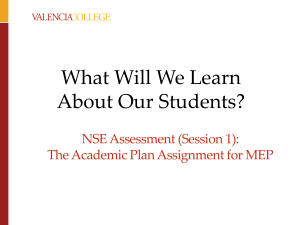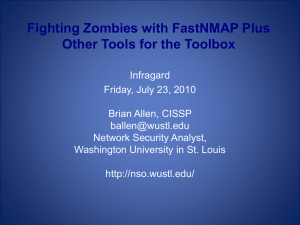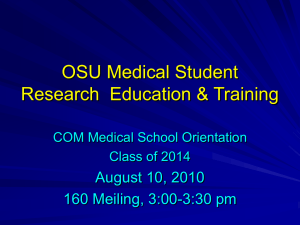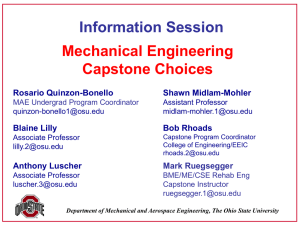National Student Exchange
advertisement
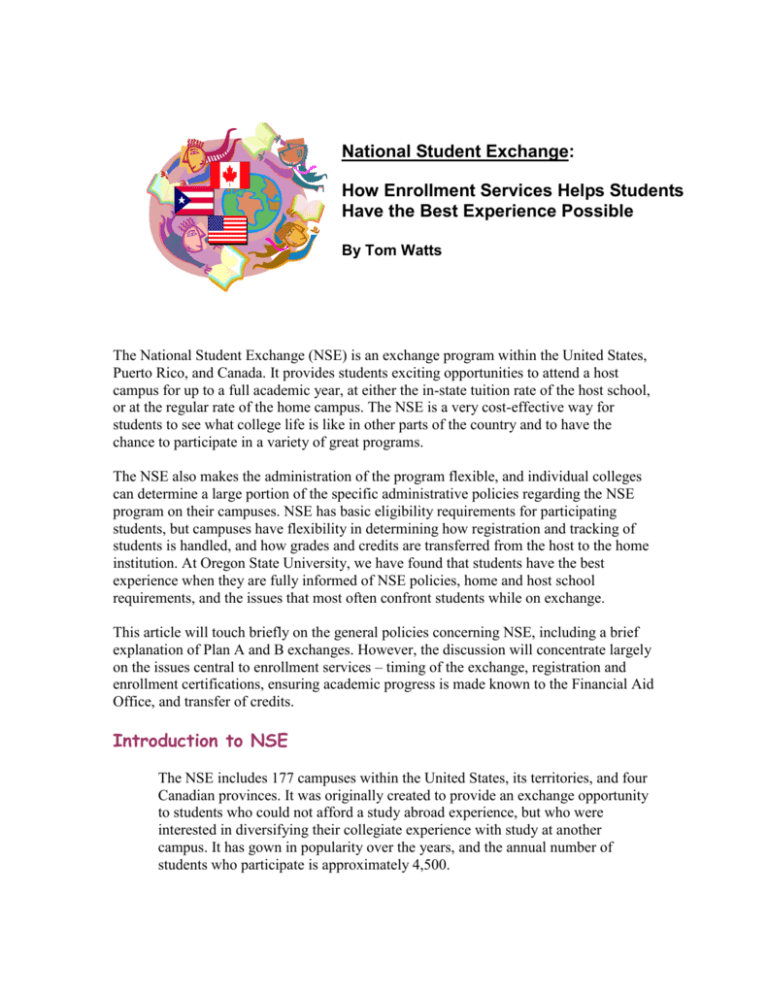
National Student Exchange: How Enrollment Services Helps Students Have the Best Experience Possible By Tom Watts The National Student Exchange (NSE) is an exchange program within the United States, Puerto Rico, and Canada. It provides students exciting opportunities to attend a host campus for up to a full academic year, at either the in-state tuition rate of the host school, or at the regular rate of the home campus. The NSE is a very cost-effective way for students to see what college life is like in other parts of the country and to have the chance to participate in a variety of great programs. The NSE also makes the administration of the program flexible, and individual colleges can determine a large portion of the specific administrative policies regarding the NSE program on their campuses. NSE has basic eligibility requirements for participating students, but campuses have flexibility in determining how registration and tracking of students is handled, and how grades and credits are transferred from the host to the home institution. At Oregon State University, we have found that students have the best experience when they are fully informed of NSE policies, home and host school requirements, and the issues that most often confront students while on exchange. This article will touch briefly on the general policies concerning NSE, including a brief explanation of Plan A and B exchanges. However, the discussion will concentrate largely on the issues central to enrollment services – timing of the exchange, registration and enrollment certifications, ensuring academic progress is made known to the Financial Aid Office, and transfer of credits. Introduction to NSE The NSE includes 177 campuses within the United States, its territories, and four Canadian provinces. It was originally created to provide an exchange opportunity to students who could not afford a study abroad experience, but who were interested in diversifying their collegiate experience with study at another campus. It has gown in popularity over the years, and the annual number of students who participate is approximately 4,500. NSE and Enrollment Services: Helping Students Have the Best Exchanges Possible, page 2 Most of the campuses are state-supported schools; however, some private colleges and universities are also part of the NSE. The policies are flexible; however, most campuses follow a plan similar to the one explained below: Eligibility. The NSE requires applicants to be full-time students at the home university, with at least a 2.5 grade point average (on a 4.0 scale). Both home and host campuses can establish eligibility requirement that are higher than the minimums, and some host campuses do require higher GPA’s for selected programs. At OSU, the majority of participants are third-year students, but sophomores, juniors, and seniors all can participate. Application Process. Students are required to apply for the program at their home campuses, and the process again can vary from campus to campus. Most campuses require an application form, plus letters of recommendations, and personal statements of exchange goals or other similar statements. Part of the requirements for participation, usually incorporated into the application process, include a written, flexible academic program for the exchange, and an agreement between the student and academic advisor concerning how the credits earned on exchange will apply to the student’s degree program. Acceptance. Applicants are accepted on host campuses on a space available basis. The acceptance process is completed in March of every year when the NSE Coordinators from all campuses attend a conference specifically for the placement of applicants. Once students are accepted, the home campus NSE Coordinator begins to assist with the preparation for the exchange, covering issues such arrangements for financial aid, housing, travel, registration, and the host campus’ expectations for visiting NSE students. Exchange Length and Location. Students can spend up to one academic year on an NSE exchange. While that length of time can be split between two different host campuses, and even in some instances between two different academic years, the NSE Coordinators strongly suggest that the NSE experience take place at one host campus, for a complete year. That allows a student to get the most personal benefit from the exchange and deriving the most from studying at a different program at a host university. Students also can explore other options with the NSE Coordinator at their home university. NSE from the Student’s Perspective Typically the most attractive aspects to students are that NSE provides the chance to choose from a wide variety of strong programs, and the opportunity to attend school in a completely different part of the country. Students make their final decisions about where to attend college based on a range of factors, and in most instances make choices between very good schools. The NSE is one way that students can broaden their collegiate experience, taking advantage of the programs another campus has to offer and widening their NSE and Enrollment Services: Helping Students Have the Best Exchanges Possible, page 3 experiences and the people they meet in college. Other students love the opportunity to go to school in a completely different part of the country, being able to take full advantage of a year-long or semester-long stay on a different campus. Students point to their NSE experience on resumes or graduate school applications, knowing that oftentimes such an experience is seen as evidence of initiative, interest, adaptability, and a willingness to get as much out of college as possible. Preparing Students for the NSE Experience Students bring enthusiasm and energy to the NSE program, as they are eager to get the most out of the experience. In the midst of that excitement it is important to make sure the energy and enthusiasm is channeled, so students are fully prepared for the program. Campuses participating in the NSE program designate a NSE Coordinator, and it is that person who is the direct contact for both the NSE students from the home campus who are going to attend other campuses, and also for the incoming NSE students from various other campuses. Some of the important issues that the NSE Coordinator helps students with include: Eligibility issues Campus selection and placement Admission and registration issues Developing an academic plan for the exchange Financial resources and housing options Transcripts and credits At OSU, the NSE Coordinator is part of Career Services, an office that has direct contact with students. The NSE Coordinator is positioned organizationally in different departments at different campuses, but for the most part the coordinators are part of departments with strong student contact. Our Coordinator facilitates the whole range of activities for incoming and outgoing NSE students, making sure that OSU students leaving on exchange are fully prepared, and providing orientation and ongoing support for NSE students coming to OSU from other campuses. NSE Options: Plan A and Plan B Exchanges One of the most important distinctions in NSE processing is the distinction between Plan A and Plan B exchanges. That distinction has direct implications on the handling of the students’ financial aid packages and the amount that the student has to pay for tuition and fees. NSE and Enrollment Services: Helping Students Have the Best Exchanges Possible, page 4 Table 1. NSE Plan A and B (Differences in processing are based on NSE administration at OSU) Exchange Areas Plan A Plan B Financial Aid Handled by host campus. Handled by home campus. Housing Costs Charged by / paid to host campus. Charged by / paid to host campus. Registration Academic registration at host campus. Academic registration at host campus. No “ghost” registration at home campus. “Ghost” registration at home campus for enrollment certification and financial aid tracking. Paid to host campus at instate rate for host campus students. Paid to home campus. Tuition based on academic registration at host campus. Tuition based on “ghost” registration at home campus. Student’s enrollment certified by the host campus. Enrollment certified by home campus (using “ghost” registration). Tuition Enrollment Certification Transcripting Grades Student’s host campus academic work is transcripted as transfer work by the home campus. Student’s host campus academic work is transcripted as transfer work by the home campus Students on Plan A exchanges pay the in-state tuition rate and fees of the host college. They must arrange for the host school to process their financial aid for the time that they are on exchange at the host school, and they will show enrollment at the host school only. The host school will certify their enrollment for all purposes. Because Plan A students essentially are incorporated completely into the campus population of the host school for the length of the exchange, they are essentially on a leave of absence from the home school as far as enrollment management processing is concerned until they return from the exchange. Students on Plan B exchanges pay their tuition and appropriate fees to their home school. In addition, their financial aid continues to be processed through their home school, and it is the home campus that certifies their enrollment. While students register for academic classes at the host school, there is usually some type of “special” registration (referred to as “ghost” registration in the table) at the home school to allow for billing, certification, and tracking. It is in the area of the NSE and Enrollment Services: Helping Students Have the Best Exchanges Possible, page 5 registration at the home school for Plan B students where a lot of the variability in processing among campuses comes into play. Both Plan A and Plan B students are expected to pay all the appropriate tuition and fees, according to the specific arrangements of the plan they are under, and it is the role of the NSE Coordinator and the various enrollment management offices to help make the registration, billing, financial aid, and transcript processes proceed without undue difficulty to the students. In practical terms, then, for OSU (as for any campus) four different types of NSE exchange students are potentially possible: OSU students on exchange under either Plan A or B, and incoming students from other campuses on either Plan A or B exchanges. OSU Plan A Students Because the OSU Plan A students are processed completely by the host campus, there are few, if any, enrollment management issues with these students during the time of their exchange. The NSE Coordinator at OSU works closely with these students to ensure that they have consulted their OSU academic advisor to develop a flexible academic plan for the exchange, especially to ensure that classes will contribute to their degree plan. Also, the NSE Coordinator at the host campus helps Plan A students understand registration, financial aid, housing, academic and other concerns at the host campus. OSU Plan B Students For OSU Plan B students, there is the greatest amount of processing by the OSU enrollment services offices. The NSE Coordinator, as with the Plan A students, ensures that the Plan B students have met with academic advisors and are fully prepared with a flexible academic agenda for the length of their exchange. The NSE Coordinator and Registrar’s Office work together to ensure that the students are registered in a class that is reserved for Plan B OSU students only. The registration in this class allows OSU to track the students for enrollment certification and at the end of the exchange to ensure that all students have submitted transcripts from the host school for evaluation by OSU. Also, the Registrar’s Office, the Financial Aid Office, and the NSE Coordinator work to ensure that the academic credits of the Plan B students are processed appropriately. Incoming Plan A and B Students For incoming students, both Plan A and Plan B, the NSE Coordinator at OSU facilitates the proper student coding for the students in the OSU NSE and Enrollment Services: Helping Students Have the Best Exchanges Possible, page 6 student information system. This, of course, allows them to register for classes and to have their academic history recorded. For incoming Plan A students, it is also important to have the correct student coding so that financial aid is processed properly, as that processing is also the responsibility of OSU for the time that the incoming (visiting) students are at OSU. In addition, the NSE Coordinator works to ensure that the students feel as though they are OSU students in every respect. The Coordinator facilitates the students’ advising, provides an orientation to the campus, and continues to offer support in a variety of ways throughout the time that they are students at OSU. Based on the information above, the bulk of the enrollment management issues deal with the processing for OSU students who are on Plan B exchanges at other universities. For the incoming students, there is a small amount of student coding to make them a part of the OSU student information system, and after that, the registration and other processing is part and parcel of the processing for all OSU students. Enrollment Services and NSE Students The remainder of the discussion deals primarily with OSU students participating in Plan B exchanges at other universities and the issues that are important in the processing for those students. There is also a brief discussion of the manner in which OSU codes the incoming NSE students. The role of the enrollment services offices is essentially to ensure that students spend as much time as possible deriving educational and personal benefits from their exchanges, and as little time as possible worrying about registrations, financial aid, credits, and many of the things that are daily challenges to each of us in enrollment services but which are sometimes completely off the radar screens for students. There are different approaches to the administrative challenges at different campuses, and, of course, each college has the flexibility to address those challenges in what they feel is the most effective way. The information about how we at OSU handle coding for incoming NSE students, NSE registrations and transcripting may be helpful for campuses looking at implementing or modifying their approach to the program. Enrollment Services for Incoming NSE Students The work that is done for incoming NSE students by enrollment services includes creating a student record for the students in the OSU student information system, and coding the student with NSE “attributes.” NSE and Enrollment Services: Helping Students Have the Best Exchanges Possible, page 7 When the placement of students is complete and the OSU NSE Coordinator knows who is going to attend OSU as an NSE exchange student from other campuses, the Coordinator compiles a list of those students and forwards it to the Admissions Office, the Registrar’s Office, and the Financial Aid Office. The list is split into two parts: the Plan A students and the Plan B students. The Admissions Office admits the students, using an abbreviated admissions process. A student record is created for each of the students, including the following information: NSE Attribute Code. NSE incoming students are “admitted” as degree-seeking students, primarily so that Plan A students are eligible for financial aid. The NSE attribute is included, though, to allow us to segregate the incoming NSE students from processes such as degree audits, progress reports, etc. In addition, the attribute coding allows us to report on these visiting students as a group, if necessary. NSE Billing Rate Code. Because for the most part the students are non-Oregon residents, a special billing rate code is entered so that the student account for incoming Plan A NSE students is billed by OSU at the Oregon resident level, or so that Plan B students are not billed for tuition by OSU. Class Standing. A class standing of Junior (third-year) is entered for the visiting students. It is very rare that visiting NSE students are not third-year or fourth-year students at their home universities. Because the visiting students will not have any OSU academic history, they would be forced to register with the first-year students, putting them at a disadvantage for getting into some of the classes. By entering a thirdyear class level for the students, they are able to register at the same time that other OSU third-year students are registering. Beyond the initial coding for the students, including the special coding above, the processing for the students during the remainder of their time at OSU is the same as for other OSU students. They register on the web, the Plan A students are billed by OSU, the Plan B student are billed by their home school, and all grading and academic history processing is completed as part of standard, automated processes. At the end of their exchanges, these students will request transcripts from the OSU Registrar’s Office, and their home universities will evaluate the coursework and articulate the classes according to the policies and procedures of their home universities. NSE and Enrollment Services: Helping Students Have the Best Exchanges Possible, page 8 Enrollment Services for OSU NSE Students The work that is done for OSU students who are visiting other campuses on NSE programs is quite different than what is necessary for the NSE students attending OSU from other campuses. OSU Plan A Students As noted earlier, because the Plan A students are essentially taking a leave of absence from OSU, there is little that enrollment management departments have to do for these students. After placing the students, the NSE Coordinator at OSU prepares the students, making sure that they understand what to expect and, most importantly, that they have created a flexible and meaningful academic plan. The students generally do their academic planning with their academic advisor, but often the Coordinator is a facilitator for this task as well as for the more general preparation for the exchange. Plan A students are “admitted” by the exchange school they are attending, and if they are on financial aid, then that also is handled by their host campus. At the end of the exchange, they will forward a transcript of their work at the host campus to the OSU Office of Admissions, and the OSU Admissions Office will evaluate the transfer work, and enter it into the students’ academic record. OSU Plan B Students For OSU Plan B students, the NSE Coordinator works with several of the enrollment management departments to make sure that the students are billed correctly, receive the appropriate financial aid, and at the end of the exchange receive the credit for classes on their OSU academic record. The NSE Coordinator is the OSU representative with the most direct contact with the students; however, several of the tasks that are required for the exchange to work smoothly for the students have to be coordinated with enrollment services departments. The aspects of the exchanges that are important for the Registrars, Admissions, or the Financial Aid Offices to know about include: Placing students in universities that they want to attend. Registering the student’s in an OSU class that is reserved for NSE Plan B students (“ghost” registration). Ensuring that the Financial Aid Office knows who the students are that are on exchange, and for what period of time. Ensuring that students’ credits are evaluated and entered on the academic record as quickly as possible. NSE and Enrollment Services: Helping Students Have the Best Exchanges Possible, page 9 Student Placement. This aspect of the exchange is important more for the timing of the exchange than for any particular processing that has to be done in conjunction with placement. For example, at OSU, the residency requirement for graduation states that a student must complete, at a minimum, 45 of the last 75 credits while the student is in academic residence at OSU. The definition of academic residence is relatively strict, and while credits earned in international programs sponsored by the Oregon University System (OUS) will count toward academic residency, the credits earned in NSE programs do not. The academic residence requirement is an important consideration that the NSE Coordinator covers with the students, as those who are thinking about the NSE program in their last year are almost always affected. The NSE strongly urges students to complete year-long exchanges, primarily because that is the best length of time for a student to get the full impact and benefit of the exchange. However, a year-long exchange results, in most instances, in OSU students earning more than 30 quarter credits, creating a problem for seniors who go on exchange. The NSE Coordinator counsels students thinking about the exchange to complete the exchange in their third year. In that way, the students can take upper-division credits at the host campus and get the most value from the exchange, and, equally as important, they are far less likely to run into difficulties with the OSU academic residence requirement. Registration at OSU. The students on Plan B do not register for academic courses at OSU. They register for all academic coursework at the host campus. However, because the enrollment certification of the students and the processing of their financial aid is done through OSU, there must be a way for OSU to identify the students as participants in the NSE program. Although the process to monitor the registration of the students does require manual intervention, the procedures that we follow allow us to do our certifications, monitoring, and financial aid processing with as little manual intervention as possible. The NSE Coordinator provides a list of OSU Plan A and Plan B students, and the colleges where they have been placed. The Registrar’s Office assists with a registration process that allows Plan B students to register as NSE participants, to be included in enrollment certifications, and to have their financial aid processed. The registration process includes these important features: 1. After the NSE Coordinator provides the list of Plan B students, the Registrar’s Office creates a registration permission for those students to register for the class reserved for Plan B students. Students can then register on the web for the class, and unless they have made other arrangements with the NSE Coordinator, the students NSE and Enrollment Services: Helping Students Have the Best Exchanges Possible, page 10 register for 16 credits. The students are thus full-time status, and the registration creates a bill for them from the OSU Office of Business Affairs. 2. At the beginning of the term, the Registrar’s Office typically checks to ensure that all the students on the list have registered for the reserved NSE Plan B class. If they have, the Registrar’s Office enters a transcript-visible comment that identifies the student as participating in the NSE, and includes the name of the university the student is attending, for example: NATIONAL STUDENT EXCHANGE UNIVERSITY OF SOUTH CAROLINA If any of the students have not registered, the Registrar’s Office will notify the NSE Coordinator so that the matter can be resolved. In some instances, the student has simply forgotten to register, while other times a student may, at the last minute, decide not to go on the exchange. It is normally the NSE Coordinator who resolves those nonregistrations. 3. For the last several years, OSU has contracted with the National Student Clearinghouse to provide enrollment certifications. By registering for the reserved NSE class, a Plan B student is automatically included in the registration information sent to the clearinghouse. Financial Aid. With their registration at OSU for the reserved NSE class, the students’ financial aid processing can be processed with fewer “special” steps than if the students were tracked completely by manual means. The Financial Aid Office can incorporate the students into most of the automated processes, and with a registration for each term that they are participating in the exchange, students provide the Financial Aid Office with the means to maintain and monitor their financial aid status. Recording NSE Credits. At the end of the exchange, it is very important for the Admissions Office, Registrar’s Office, and Financial Aid Office to communicate and ensure that the final record of the students for their exchange is complete. As noted earlier, the NSE credits are recorded as transfer credits. Students complete their registration for the reserved NSE class for each quarter that they are on exchange (usually, students are on exchange for the Fall, Winter, and Spring quarters). At the end of each quarter that the Plan B students are on exchange, they will receive an “Incomplete” (I) for the grade in the reserved NSE class. NSE and Enrollment Services: Helping Students Have the Best Exchanges Possible, page 11 The I grade will remain on their academic record until the transcript is received by the OSU Admissions Office, and the credits evaluated and entered to the student’s academic record. When the credits grades are recorded by Admissions, then the Registrar’s Office removes the reserved NSE class that the students registered for. The removal of the course also removes the "I” grade from the student’s record. No institutional credit will be recorded for the terms that the student is on NSE; however, there will be a transcript comment for those terms that indicates that the student was on NSE and the university where the student attended. After the removal of the NSE registration class, the Registrar’s Office notifies the Financial Aid Office that the NSE credits from the student’s host campus have been entered in academic history. At that time, Financial Aid is able to review the student record to ensure the student has made acceptable academic progress, and complete any other necessary processing for the student’s financial aid package. Contributing to an Excellent NSE Experience The NSE program affords qualified students with a tremendous avenue to expand their collegiate experience in a variety of ways. Students are enthusiastic about the program and generally thrive on the challenges and opportunities. While it is not the easiest program to administer, it can be handled so that the difficulties are minimal for enrollment services departments, and so that students are able to focus on the academic and personal benefits that the program offers. About the author: Tom Watts is the Special Programs Manager in the Registrar’s Office of Oregon State University. Joined the OSU Registrar’s Office in March 2001, from El Paso, Texas, where he worked for the Ysleta Independent School District, El Paso County, and private industry. A newcomer to PACRAO, his first conference attended was Victoria, B. C. in 2002. Email address: tom.watts@orst.edu
